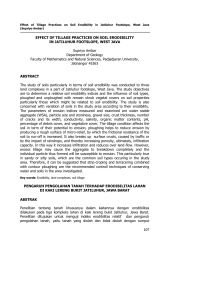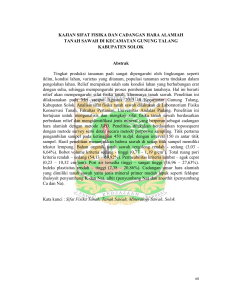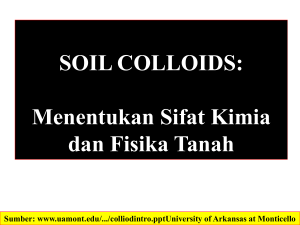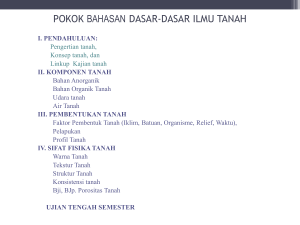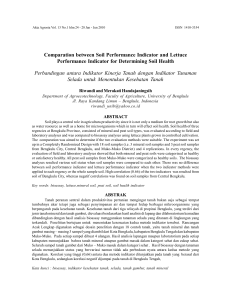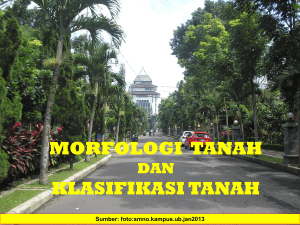dit-temperatur tanah dan tanaman
advertisement
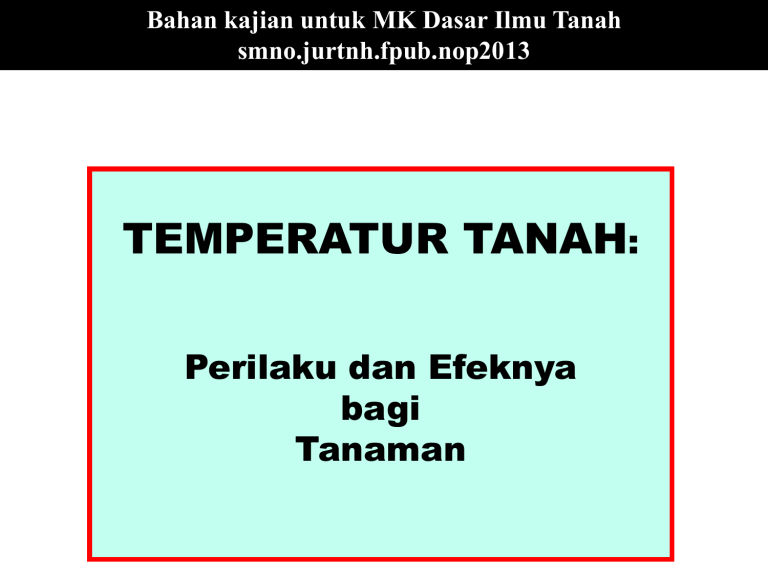
Bahan kajian untuk MK Dasar Ilmu Tanah smno.jurtnh.fpub.nop2013 TEMPERATUR TANAH: Perilaku dan Efeknya bagi Tanaman TEMPERATUR TANAH Temperatur atau Suhu adalah tingkat kemampuan benda dalam memberi atau menerima panas. Suhu seringkali juga dinyatakan sebagai energi kinetis rata-rata suatu benda yang dinyatakan dalam derajat suhu. Suhu juga dinyatakan sebagai ukuran energi kinetik rata-rata dari pergerakkan molekul suatu benda. Suhu menunjukkan sangkar cuaca yang dipergunakan untuk pengamatan suhu. Pengukuran dilakukan dengan menggunakan thermometer air raksa dan alkohol. Dengan thermometer air raksa pengukuran dapat dilakukan dari suhu 35o C – 350o C, hasilnya adalah cukup bagus karena mengingat angka pengembangan air raksa pada tiap suhu lebih merata dari alkohol, sehingga untuk pengukuran suhu udara biasanya digunakan thermometer air raksa. http://blkmtncommunitygarden.blogspot.com/2010/03/soil-temperature-chart-for-seed.html Pentingnya temperatur tanah? Temperatur tanah Salah satu sifat fisika tanah yang sangat berpengaruh terhadap proses-proses dalam tanah, seperti pelapukan dan penguraian bahan organik dan bahan induk tanah, reaksi-reaksi kimia , dll. Example of soil moisture and temperature during and after freezing. (Gravimetrically determined θv was 11.8 % on day 0 and 11.3% on day 9.) Soil moisture measurement in the Ross Sea region of Antarctica using Hydra soil moisture probes. Aaron M. Wall, Megan R. Balks, Dave I. Campbell and Ron F. Paetzold http://www.regional.org.au/au/asssi/supersoil2004/s15/oral/1502_walla.htm diunduh 15/2/2012 Faktor-faktor yang mempengaruhi suhu tanah : 1. Faktor iklim / cuaca – – – – – – radiasi surya Keawanan Hujan suhu udara Angin kelembaban udara The soil temperature is much less influenced by climatic changes. The graph shows the variation in temperature over a year at different depths (0, 2, 5 and 12 feet). As we can see, the temperature fluctuation decreases with increasing depth. Sumber: http://www.enviroair.ca/en/geothermal.html..... . diunduh 12/2/2012 Faktor-faktor yang mempengaruhi suhu tanah : 2. Keadaan tanah – – – – – tekstur tanah kadar air tanah kandungan bahan organik warna tanah struktur tanah (pengolahan ddan kepadatan tanah) Depth dependence of annual range of ground temperatures in Ottawa, Canada (Williams and Gold 1976, National Research Council of Canada 2003). Sumber: http://iopscience.iop.org/1748-9326/2/4/044001/fulltext/ diunduh 12/2/2012 Faktor-faktor yang mempengaruhi suhu tanah : 3. Kondisi topografi – – – – kemiringasn lereng arah lerreng tinggi permukaan tanah vegetasi Definition ofthe Temperature Vegetation Dryness Index (TVDI). TVDIfor a given pixel (NDVI,Ts) is estimated as the relation between the distance ofthe pixel from the wet edge (TVDI=O) and the spån ofTs in the Ts/NDVI-spacefor the given NDVI (the difference between Ts and the dry edge (TVDI=I) and Ts at the wet edge). SUMBER: http://www.tidsskrift.dk/visning.jsp?markup=&print=no&id=71866 Diunduh 12/2/2012) Pentingnya temperatur tanah 1. Temperatur tanah mempengaruhi aktivitas biologi tanah---- tidak optimal apabila suhu tertentu tidak dapat dipertahankan • Tingkat aktivitas optimum dari organisme tanah adalah suhu 18 – 30oC • Kurang dari 10o C: menghambat perkembangan mikroba tanah dan menghambat penyerapan hara oleh akar tanaman • Lebih dari 40oC : mikroba tanah tidak aktif, kecuali mikroorganisme tertentu (termofilik). PENTINGNYA TEMPERATUR TANAH 2. • Temperatur tanah juga menentukan reaksi kimia dan aktivitas mikroba tanah yang dapat merombak senyawa organik tertentu menjadi hara tersedia. Proses nitrifikasi ( temperatur optimum ± 30o C ), yaitu pada kondisi agak panas http://info.cycadpalm.com/bid/57663/How-to-Fertilize-Cycads-Part-2 diunduh 15/2/2012 Pentingnya temperatur tanah 3. 4. 5. Temperatur tanah juga mempengaruhi pelapukan bahan induk tanah Temperatur tanah mempengaruhi perkembangan akar, karena ada hubungannya dengan kelengasan dan aerasi tanah Temperatur tanah mempengaruhi pekecambahan biji dan pertumbuhan kecambah Effect of soil temperature on nitrate formation (adapted from Fredereick and Broadbent, 1966). http://www.ipm.iastate.edu/ipm/icm/2001/10-22-2001/why50.html … diunduh 15/2/2012 Pentingnya temperatur tanah pertumbuhan tanaman tertentu (jenis berbeda) menghhendaki keadaan temperatur yang cocok. http://www.cropinfo.net/AnnualReports/2003/YNSResponsetoEnvironment03.htm.... .. Diunduh 12/2/2012 SUHU TANAH BAGI CACING Suhu atau temperatur tanah yang ideal untuk pertumbuhan cacing tanah dan penetasan kokonnya berkisar antara 15oC – 25oC. Suhu tanah yang lebih tinggi dari 25oC masih cocok untuk cacing tanah, tetapi harus diimbangi dengan kelembapan yang memadai dan naungan yang cukup. Oleh karena itu, cacing tanah biasanya ditemukan hidup dibawah pepohonan atau tumpukan bahan organik. http://biologi.lkp.web.id/?p=604 diunduh 3/2/2012 Dimana suhu tanah diukur? Termometer Tanah Used to take temperatures at 5 and 10 cm depths PVC Spacer PVC Spacer Kalibrasi Termometer tanah Basically, we compare the soil thermometer to a calibration thermometer, and adjust the soil thermometer. First, we need to check the calibration thermometer!! …by dipping it in an ice bath. Checking Calibration Thermometer • Submerge thermometer in ice-water bath • Let sit for 10-15 minutes, stirring thermometer occasionally • Read the thermometer. If it reads between -0.5° C and +0.5° C, the thermometer is fine. • If the thermometer reads greater than +0.5° C, check to make sure that there is more ice than water in your ice-water bath. • If the thermometer reads less than 0.5° C, check to make sure that there is no salt in your ice-water bath. Kalibrasi Termometer Tamah • Add the soil thermometer to the ice bath • Wait 2 minutes • Read both Soil Thermometer and calibration thermometer. • If they agree to within ±2° C, the soil thermometer is ready to use. • If not adjust the soil thermometer, using a wrench, until it reads with ±2° C of the calibration thermometer Kapan mengukur suhu tanah ? • Soil temperature is a weekly measurement, but you can do it daily. • Try to do the measurement at about the same time of day • Take data near the atmosphere station or near the soil moisture site • Also measure soil temperature measurement whenever a soil moisture data are taken • Seasonally (4 times a year), measure soil temperature every few hours during the day for 2 consecutive days – provides a diurnal reading of soil temperature change – diurnal sampling in March, June, Sept. and Dec. are preferred Regim Temperatur Tanah --- Regim temperatur tanah RTTT RTTMP-RTTMD RTTMP Pergelik Cryik Frigid Isofrigid Boreal Mesik Isomesik Termik Isotermik Hipertermik Isohipertermik < 0 0–8 0–8 0–8 <8 8 – 15 8 – 15 15 – 22 15 – 22 > 22 > 22 >5 <5 >5 <5 >5 <5 >5 <5 Rendah > cryic Estimasi temperatur berdasarkan ketinggian tempat (elevasi) Di tempat-tempat yang tidak tersedia data temperatur (stasiun iklim terbatas), maka temperatur udara dapat diduga berdasarkan ketinggian tempat (elevasi) dari atas permukaan laut. Pendugaan tersebut dengan menggunakan pendekatan rumus dari Braak (1928) dalam Mohr et al. (1972). Berdasarkan hasil penelitiannya di Indonesia temperatur di dataran rendah (pantai) berkisar antara 25-27ºC, dan rumus yang dapat digunakan (rumus Braak) adalah sebagai berikut: 26,3°C - (0,01 x elevasi dalam meter x 0,6°C) Berdasarkan penelitian Braak tersebut temperatur tanah pada kedalaman 50 cm di Indonesia lebih tinggi 3-4,5ºC, sehingga untuk menduga temperatur tanah pada kedalaman 50 cm, maka rerata temperatur udara ditambah sekitar 3,5ºC. Menurut Wambeke et al. (1986) temperatur tanah lebih tinggi 2,5ºC dari temperatur udara. Hasil pendugaan temperatur dan ditambah perbedaan temperatur udara dan temperatur tanah tersebut digunakan untuk menentukan rejim temperatur tanah seperti yang ditetapkan dalam Taksonomi Tanah (Soil Survey Staff, 1992; 1998). RADIASI MATAHARI Permukaan bumi merupakan penyerap utama radiasi matahari . Oleh sebab itu permukaan bumi merupakan sumber panas bagi udara di atasnya dan bagi lapisan tanah di bawahnya. Pada siang hari suhu permukaan tanah akan lebih tinggi dibandingkan dengan suhu pada lapisan tanah yang lebih dalam. Permukaan tanah menyerap radiasi matahari secara langsung pada siang hari, setelah itu panas merambat ke lapisan tanah yang lebih dalam. Sebaliknya pada malam hari permukaan tanah akan kehilangan panas terlebih dahulu, akibatnya suhu pada permukaan tanah akan lebih rendah dibandingkan dengan suhu pada lapisan yang lebih dalam. Pada malam hari panas akan merambat dari lapisan yang lebih dalam menuju permukaan. Sumber: STUDI DIFUSIVITAS TERMAL PADA MEDIUM TANAH MELALUI PENGUKURAN SUHU. Aries Astradhani Subgan. Natural, Oktober 2006. Vol 5. No.2 PERPINDAHAN PANAS Proses perpindahan panas yang terjadi di dalam tanah adalah perpindahan panas secara konduksi. Proses perpindahan panas ini terjadi karena adanya gerakan molekul dalam tanah. Temperatur adalah suatu pernyataan tentang kinetik energi molekul benda, adanya suatu beda suhu di dalam suatu benda umumnya akan menyebabkan perpindahan energi kinetik oleh banyaknya tumbukan dari molekul-molekul yang bergerak dari daerah yang lebih panas ke daerah sekitarnya yang lebih dingin. Sumber: STUDI DIFUSIVITAS TERMAL PADA MEDIUM TANAH MELALUI PENGUKURAN SUHU. Aries Astradhani Subgan. Natural, Oktober 2006. Vol 5. No.2 TRANSFER PANAS Proses stedi (steady;) atau proses takstedi (unsteady) terjadi dalam proses transfer panas. Bilamana laju aliran panas dalam suatu sistem tidak berubah dengan waktu (konstan), maka suhu dititik manapun tidak berubah. Hal ini yang dikatakan kondisi keadaan-stedi. Dengan kondisi keadaan-stedi (steady state), kecepatan fluks-masuk pada titik manapun dari sistem manapun harus tepat sama dengan kecepatan fluks-keluar, dan tidak dapat terjadi perubahan energi-dalam. Aliran panas dalam suatu sistem takstedi terjadi bila suhu diberbagai titik dari sistem tersebut berubah dengan waktu. Sumber: STUDI DIFUSIVITAS TERMAL PADA MEDIUM TANAH MELALUI PENGUKURAN SUHU. Aries Astradhani Subgan. Natural, Oktober 2006. Vol 5. No.2 Dengan adanya perubahan suhu, maka akan terjadi perubahan energi dalam. Perubahan kandungan panas dari sebuah permukaan tanah antara permukaan Z1 = 0 dan beberapa kedalaman Z2 diberikan oleh : AS = - (qh2 – qh1) ≈ q z h z Dimana qh positif ke arah bawah http://www.texasgeology.com/ac_heat_pumps.html Sumber: STUDI DIFUSIVITAS TERMAL PADA MEDIUM TANAH MELALUI PENGUKURAN SUHU. Aries Astradhani Subgan. Natural, Oktober 2006. Vol 5. No.2 KERAPATAN FLUX PANAS Kerapatan fluks panas tanah positif arah bawah ketika ΔS = (qh2 - qh1) positif, maka lebih banyak panas yang masuk di bagian atas daripada yang meninggalkan bagian bawah lapisan tanah sehingga tanah menjadi panas. Jika ΔS = - (qh2 - qh1) negatif, maka lebih banyak panas yang keluar daripada yang masuk ke permukaan sehingga tanah menjadi dingin. Sumber: STUDI DIFUSIVITAS TERMAL PADA MEDIUM TANAH MELALUI PENGUKURAN SUHU. Aries Astradhani Subgan. Natural, Oktober 2006. Vol 5. No.2 TRANSFER PANAS Teori transfer panas dalam tanah telah digunakan untuk menentukan sifat-sifat termal rata-rata dari regim suhu yang diamati, juga untuk pendugaan perubahan harian dan musiman suhu tanah. di alam, tanah yang homogen hanya terdapat pada lapisan-lapisan yang tipis, sehingga suhu tanah umumnya bukanlah fungsi sinus sederhana. Amplitude of seasonal soil temperature change as a function of depth below ground surface. http://www.builditsolar.com/Pro jects/Cooling/EarthTemperature s.htm Sumber: STUDI DIFUSIVITAS TERMAL PADA MEDIUM TANAH MELALUI PENGUKURAN SUHU. Aries Astradhani Subgan. Natural, Oktober 2006. Vol 5. No.2 Grafik Fungsi Fourier Suhu Tanah Bervegetasi Tiap Kedalaman 36 35 34 33 Suhu Tanah 32 (0C) 31 30 Z=0 Cm 29 Z=5 Cm 28 Z=10 Cm 27 Z=15 Cm 26 Z=20 Cm 25 Z=25 Cm 24 23 22 0 1 2 3 4 5 6 7 8 9 10 11 12 13 14 15 16 17 18 19 20 21 22 23 24 Waktu Pengamatan Waktu Per 30 Menit Sumber: STUDI DIFUSIVITAS TERMAL PADA MEDIUM TANAH MELALUI PENGUKURAN SUHU. Aries Astradhani Subgan. Natural, Oktober 2006. Vol 5. No.2 Grafik Fungsi Fourier Suhu Tanah Tidak Bervegetasi Tiap Kedalaman 46 45 44 43 42 41 40 Suhu 39 Tanah 38 37 (0C) 36 35 34 33 32 31 30 29 28 27 26 25 24 23 22 21 20 19 0 1 2 Z=0 Cm 3 4 5 6 Z=5 Cm 7 8 9 10 11 12 13 14 15 16 17 18 19 20 21 22 23 24 Waktu Pengamatan Waktu Per 30 Menit Z=10 Cm Z=15 Cm Z=20 Cm Z=25 Cm Sumber: STUDI DIFUSIVITAS TERMAL PADA MEDIUM TANAH MELALUI PENGUKURAN SUHU. Aries Astradhani Subgan. Natural, Oktober 2006. Vol 5. No.2 TEMPERATUR TANAH Temperatur (suhu) adalah salah satu sifat tanah yang sangat penting secara langsung mempengaruhi pertumbuhan tanaman dan juga terhadap kelembapan, aerasi, stuktur, aktifitas mikroba, dan enzimetik, dekomposisi serasah atau sisa tanaman dan ketersidian hara-hara tanaman. Tenperatur tanah merupakan salah satu faktor tumbuh tanaman yang penting sebagaimana halnya air, udara dan unsur hara. Proses kehidupan bebijian, akar tanaman dan mikroba tanah secara langsung dipengaruhi oleh temperatur tanah Hanafiah, Kemas Ali. 2005. Dasar-dasar Ilmu Tanah. PT. Radja Grifindo. Persada. Jakarta. FAKTOR SUHU TANAH Tentang suhu tanah pengaruhnya penting sekali pada kondisi tanah itu sendiri dan pertumbuhan tanaman. Pengukuran dari suhu tanah biasanya dilakukan pada kedalaman 5 cm, 10 cm, 20 cm, 50 cm, dan 100 cm. Faktor pengaruh suhu tanah yaitu faktor luar dan faktor dalam. Faktor luar yaitu radiasi matahari, awan, curah hujan, angin, kelembapan udara. Faktor dalamnya yaitu faktor tanah, struktur tanda, kadar iar tanah, kandungan bahan organik, dan warna tanah. Makin tinggi suhu maka semakin cepat pematangan pada tanaman Kartasapoetra, dkk. 2005. Teknologi Konservasi Tanah. Rineka jaya. Jakarta. FLUKTUASI SUHU TANAH Suhu tanah beraneka ragam dengan cara khas pada perhitungan harian dan musiman. Fluktasi terbesar dipermukaan tanah dan akan berkurang dengan bertambahnya kedalaman tanah. Kelembapan waktu musiman yang jelas terjadi, karena suhu tanah musiman lambat bantuk fluktasi suhu pada peralihan suhu diudara atau dibawah tanah yang lebih besar. Suhu total untuk semalam tanaman mungkin terjadi pada tengah hari. Dibawah 6 inch atau 15 inch terdapat variasi harian pada suhu tanah Sosrodorsono. 2006. Variasi Tanah. Rineka Jaya. Bogor. TEMPERATUR TANAH Data temperatur tanah dapat dilihat pada Tabel 4 menunjukkan bahwa suhu harian pada permukaan tanah sangat fluktuasi dengan pola mendekati fungsi sinusoidal. Fluktuasi temperatur permukaan tanah dipengaruhi oleh perubahan suhu atmosfir di atas permukaan tanah. Temperatur tanah pada pagi hari relatif kecil, temperatur tanah pada pagi hari di lahan naungan cenderung lebih tinggi daripada di areal lahan tanpa naungan. PENGARUH IRIGASI DAN NAUNGAN TERHADAP PRODUKSI TANAMAN CABE (Capsicum annum) PADA LAHAN BERPASIR DI PANTAI GLAGAH, YOGYAKARTA Ikhwanuddin Mawardi dan Sudaryono. 2008. J. Hidrosfir Indonesia Vol. 3(1) : 41 -49 SUHU TANAH - KEDALAMAN Pada variasi kedalaman yaitu permukaan tanah, kedalaman 10 cm, 20 cm dan 30 cm, untuk temperatur tanah dalam naungan memiliki temperatur yang tertinggi, sedangkan kedalaman 10 cm mempunyai temperatur tanah terendah. Hal ini disebabkan pada pagi hari permukaan tanah telah menerima pancaran radiasi matahari, tetapi transfer panas belum mencapai kedalaman 10 cm. Temperatur tanah pada kedalaman 30 cm lebih tinggi dibandingkan kedalaman 10 SUHU TANAH – SIANG AHRI Temperatur tanah pada siang hari, jika dilihat pada tabel tersebut dapat dilihat bahwa temperatur tanah pada sing hari lebih panas daripada temperatur tanah pada pagi hari. Hal ini dapat terjadi karena pada siang hari radiasi yang diterima oleh permukaan tanah lebih besar. Temperatur tanah pada siang hari di areal lahan dengan memakai naungan lebih tinggi daripada lahan yang tidak memakai naungan. SUHU TANAH - LAPISAN TANAH Berdasarkan variasi kedalaman, maka permukaan tanah mempunyai temperatur tanah tertinggi, sedangkan kedalaman 30 cm mempunyai temperatur tanah terendah. Jadi pada siang hari temperatur permukaan tanah akan lebih tinggi jika dibandingkan temperatur pada lapisan tanah yang lebih dalam. Hal ini disebabkan karena permukaan tanah menyerap radiasi matahari secara SUHU TANAH - KEDALAMAN Temperatur tanah pada sore hari akan lebih kecil dibandingkan dengan temperatur tanah pada pagi dan siang hari. Temperatur tanah dalam naungan lebih tinggi daripada di areal lahan tanpa naungan. Berdasarkan variasi kedalaman, pada kedalaman 10 cm mempunyai temperatur tanah tertinggi sedangkan kedalaman 30 cm memiliki temperatur tanah terendah. Tingginya temperatur tanah pada kedalaman 10 cm dapat FLUKTUASI SUHU TANAH Bila dilihat dari hasil pengamatan selama 3 bulan, baik itu pagi, siang dan sore hari terlihat temperatur tanah berfluktuasi, dan cenderung lebih stabil seiring dengan bertmbahnya umur tanaman. Fluktuasi temperatur pada permukaan tanah lebih besar daripada kedalaman 10 cm, 20 cm dan 30 cm. Hal ini tidak terlepas dari pengaruh intensitas radiasi matahari yang diterima oleh permukaan tanah. Jadi intensitas radiasi matahari yang berfluktuasi akan Soil temperatures over three days at different depths. Sumber: http://www.learner.org/jnorth/tm/tulips/SoilTempBack.html..... 12/2/2012 diunduh Suhu Tanah • Relation of Soil & Air Temp – Net heat absorbed by the Earth = heat lost in form of longwave radiation – Photoperiod – affected by latitude – Soil temp can change by soil depth & time of day • Takes significant air temp changes to change soil temp deeper than 12” (& more than just daily range) Suhu Tanah • Factors Affecting Soil Temp – How much heat reaches the soil surface • • • • • Tutupan muka tanah Mulsa plastik Sudut datang radiasi matahari Arah Muka Lereng Tanah Suhu Tanah – What happens to the heat in the soil (dissipation) • Amount of heat needed to change soil temp = heat capacity – Greatly affected by soil water content » How? – Thermal conductivity – increases w/ soil-water content increasing, decreases as air-filled pores increase • Moist soils resist temp change, but conduct heat readily • Dry soils change temp faster, but conduct heat poorly – What does this mean for the soil, which is better? Suhu Tanah • Living w/ Existing Temps – Maximizing seed germination & growth • Wheat – 40 to 50° F • Corn – 50 to 85° F – When using anhydrous • Apply when soil temp @ 4” is 50° F or less – Mereduksi kehilangan N – Freeze/thaw • May cause heaving – resulting in death of shallow rooted crops Suhu tanah – Responsible for bringing stones to the surface in fields • Modifying Temp Effects – If you have crops that are feasible/profitable to do so – Clear plastic surface covers • Increases soil temp faster – Clear plastic mulches • Can speed growth & maturity of sweet corn & strawberries CIRI THERMAL TANAH The thermal properties of soil are a component of soil physics that has found important uses in engineering, climatology and agriculture. These properties influence how energy is partitioned in the soil profile. While related to soil temperature, it is more accurately associated with the transfer of heat throughout the soil, by radiation, conduction and convection. The main soil thermal properties are: Volumetric heat capacity, SI Units: J.m-3∙K-1 Thermal conductivity, SI Units: W.m-1∙K-1 Thermal diffusivity , SI Units: m2∙s-1 . http://en.wikipedia.org/wiki/Soil_thermal_properties ….. Diunduh 4/2/2012 SUHU TANAH dipengartuhi oleh: Latitude; season net radiation at the surface soil texture ; moisture content ground cover surface weather conditions . http://en.wikipedia.org/wiki/Soil_thermal_properties ….. Diunduh 4/2/2012 CIRI-CIRI THERMAL TANAH So, in order to determine the skin temperature of the soil, it is important to understand how heat is transferred upward and and downward through the soil. The important heat transfer mechanism in this problem is conduction. Then, the ground heat flux at any depth in the soil can be given as: where kg is the thermal diffusivity of the soil. http://apollo.lsc.vsc.edu/classes/met455/notes/section6/2.html .... diunduh 5/2/2012 Using the Second Law of Thermodynamics, show that a prognostic equation for the soil temperature can be given by: (2) where Cg is the soil heat capacity (Cg = soil density, r, times the soil specific heat, c) combining (2) with (1) yields: (3) where vg = kg/Cg = soil thermal diffusivity. Given proper boundary conditions, (3) can be solved to find the soil temperature at different levels as a function of time. With appropriate boundary conditions, solutions to (3) show that soil temperature decreases exponentially with depth and that the phase of the temperature changes with depth as well, consistent with the figures shown above. http://apollo.lsc.vsc.edu/classes/met455/notes/section6/2.html .... diunduh 5/2/2012 Typical values of the mass density, specific heat, thermal conductivity and thermal diffusivity for different materials THERMAL CONDUCTIVITY (kg) (W m-2 K-1) THERMAL DIFFUSIVITY (vg) (m2 s-1 x10-6) 1.01 0.025 20.5 1.00 4.19 0.57 0.14 0 Deg C, Pure 0.92 2.10 2.24 1.16 Snow Fresh 0.10 2.09 0.08 0.38 Snow Old 0.48 2.09 0.42 0.05 Sandy Soil Fresh 1.60 0.80 0.30 0.24 Clay Soil Dry 1.60 0.89 0.25 0.18 Peat Soil Dry 0.30 1.92 0.06 0.10 Rock Solid 2.70 0.75 2.90 1.43 MASS DENSITY (r) (kg SPECIFIC HEAT (c) m-3 x 103) (J kg-1 K-1 x 103) MATERIAL CONDITION Air 20 Deg C, Still 0.0012 Water 20 Deg C, Still Ice http://apollo.lsc.vsc.edu/classes/met455/notes/section6/2.html ..... Diunduh 6/2/2012 FLUKTUASI SUHU TANAH Soil temperature variations decrease exponentially with depth. only small fluctuations are observed at depths of about 1 meter. much smaller fluctuations are observed at depths of 10 meters. http://apollo.lsc.vsc.edu/classes/met455/notes/section6/2.html ..... Diunduh 6/2/2012 KAPASITAS PANAS VOLUMETRIK Volumetric heat capacity (VHC), also termed volumespecific heat capacity, describes the ability of a given volume of a substance to store internal energy while undergoing a given temperature change, but without undergoing a phase change. It is different from specific heat capacity in that the VHC depends on the volume of the material, while the specific heat is based on the mass of the material (or occasionally the molar quantity of the material). If given a specific heat value of a substance, one can convert it to the VHC by multiplying the specific heat by the density of http://en.wikipedia.org/wiki/Volumetric_heat_capacity … diunduh 5/2/2012 KAPASITAS PANAS Dulong and Petit predicted in 1818 that the product of solid substance density and specific heat capacity (ρcp) would be constant for all solids. This amounted to a prediction that volumetric heat capacity in solids would be constant. This quantity was proportional to the heat capacity per atomic weight (or per molar mass), which suggested that it is the heat capacity per atom (not per unit of volume) which is closest to being a constant in solids. Eventually (see the discussion in heat capacity) it has become clear that heat capacities per particle for all substances in all states are the same, to within a factor of two, so long as temperatures are not in the cryogenic range. For very cold temperatures, heat capacities fall drastically and eventually approach zero as temperature approaches zero. http://en.wikipedia.org/wiki/Volumetric_heat_capacity … diunduh 5/2/2012 KAPASITAS PANAS VOLUMETRIK . The heat capacity on a volumetric basis in solid materials at room temperatures and above varies more widely, from about 1.2 to 4.5 MJ/m³K, but this is mostly due to differences in the physical size of atoms. If all atoms were the same size, molar and volumetric heat capacity would differ by a single constant reflecting ratios of the atomic-molarvolume of materials (their atomic density), plus an additional number between 1 and 2 which reflects degrees of freedom for the atoms compositing the substance at various temperatures. For liquids, the volumetric heat capacity is narrower: in the range 1.3 to 1.9 MJ/M³k. This reflects the modest loss of degrees of freedom for particles in http://en.wikipedia.org/wiki/Volumetric_heat_capacity … diunduh 5/2/2012 liquids as compared with solids. KAPASITAS PANAS VOLUMETRIK Since the bulk density of a solid chemical element is strongly related to its molar mass (usually about 3 R per mole, as noted above), there exists noticeable inverse correlation between a solid’s density and its specific heat capacity on a per-mass basis. This is due to a very approximate tendency of atoms of most elements to be about the same size, despite much wider variations in density and atomic weight. These two factors (constancy of atomic volume and constancy of mole-specific heat capacity) result in a good correlation between the volume of any given solid chemical element and its total heat capacity. Another way of stating this, is that the volume-specific heat capacity (volumetric heat capacity) of solid elements is roughly a constant. The molar volume of solid elements is very roughly constant, and (even more reliably) so also is the molar heat capacity for most solid substances. These two factors determine the volumetric heat capacity, which as a bulk property may be striking in consistency. For example, the element uranium is a metal which has a density almost 36 times that of the metal lithium, but uranium's volumetric heat capacity is only about 1.2 times larger than lithium's. http://en.wikipedia.org/wiki/Volumetric_heat_capacity … diunduh 5/2/2012 . KONDUKTIVITAS THERMAL Thermal conductivity, k, is the property of a material's ability to conduct heat. It appears primarily in Fourier's Law for heat conduction. Heat transfer across materials of high thermal conductivity occurs at a higher rate than across materials of low thermal conductivity. Correspondingly materials of high thermal conductivity are widely used in heat sink applications and materials of low thermal conductivity are used as thermal insulation. Thermal conductivity of materials is temperature dependent. The reciprocal of thermal conductivity is thermal resistivity. http://en.wikipedia.org/wiki/Volumetric_heat_capacity … diunduh 5/2/2012 SUHU TANAH - MUSIMAN Soil temperature varies from month to month as a function of incident solar radiation, rainfall, seasonal swings in overlying air temperature, local vegetation cover, type of soil, and depth in the earth. Due to the much higher heat capacity of soil relative to air and the thermal insulation provided by vegetation and surface soil layers, seasonal changes in soil temperature deep in the ground are much less than and lag significantly behind seasonal changes in overlying air temperature. Thus in spring, the soil naturally warms more slowly and to a lesser extent than the air, and by summer, it has become cooler than the overlying air and is a natural sink for removing heat from a building. Likewise in autumn, the soil cools more slowly and to a lesser extent than the air, and by winter it is warmer than the overlying air and a natural source for adding heat to a building. At soil depths greater than 30 feet below the surface, the soil temperature is relatively constant, and corresponds roughly to the water temperature measured in groundwater wells 30 to 50 feet deep. This is referred to as the “mean earth temperature.” http://en.wikipedia.org/wiki/Volumetric_heat_capacity … diunduh 5/2/2012 SUHU TANAH – FLUKTUASI MUSIMAN The amplitude of seasonal changes in soil temperature on either side of the mean earth temperature depends on the type of soil and depth below the ground surface. In Virginia the amplitude of soil temperature change at the ground surface is typically in the range of 20-25ºF, depending on the extent and type of vegetation cover. At depths greater than about 30 feet below the surface, however, the soil temperature remains relatively constant throughout the year, as shown in Figure 3, below. http://en.wikipedia.org/wiki/Volumetric_heat_capacity … diunduh 5/2/2012 SUHU TANAH – KEDALAMAN PROFIL. . http://www.geo4va.vt.edu/A1/A1.htm …. Diunduh 5/2/2012 SUHU TANAH - VARIASI HORISONTAL Vertical closed-loop earth heat exchangers are installed in boreholes 200 to 300 feet deep, where seasonal changes in soil temperature are completely damped out. Well-based open-loop systems also extend to this depth or deeper. These ground loop configurations are thus exposed to a constant year-round temperature. On the other hand, horizontal-loop, spiral-loop, and horizontal directexpansion (DX) loops are installed in trenches that usually are less than 10 feet deep. For these types of ground loops, it is important to accurately know the expected seasonal changes in the surrounding soil temperature. The extra cost of installing such systems in deeper trenches may be outweighed by the gain in thermal performance, since deeper soils have less pronounced seasonal temperature changes and are thus closer to room temperature, which reduces the work load of the heat pump units. . http://www.geo4va.vt.edu/A1/A1.htm …. Diunduh 5/2/2012 SUHU TANAH – KEDALAMAN Deeper soils not only experience less extreme seasonal variations in temperature, but the changes that do occur lag farther behind those of shallower soils. This shifts the soil temperature profile later in the year, such that it more closely matches the demand for heating and cooling. The maximum soil temperature occurs in late August (when cooling demand is high) at a depth of 5 feet below the ground surface, but occurs in late October (after the heating season has begun) at a depth of 12 feet below the surface. Thus a deeper ground loop installation would lower the annual operating cost for electrical energy to run the heat pumps, and over the life of a GHP system, these accumulated savings may more than offset the higher capital cost of burying the ground loop more deeply. In order to determine the optimal depth of burial, it is important to accurately know how the seasonal change in soil temperature varies with depth, which is mainly determined by the soil's thermal properties. . http://www.geo4va.vt.edu/A1/A1.htm …. Diunduh 5/2/2012 . Seasonal soil temperature change as a function of depth below ground surface for an average moist soil. . http://www.geo4va.vt.edu/A1/A1.htm …. Diunduh 5/2/2012 CIRI-CIRI THERMAL TANAH Heat capacity (also known as specific heat) indicates the ability of a substance to store heat energy; the greater its heat capacity, the more heat it can gain (or lose) per unit rise (or fall) in temperature. The heat capacity of dry soil is about 0.20 BTU per pound per ºF of temperature change, which is only one-fifth the heat capacity of water. Therefore, moist or saturated soils have greater heat capacities, typically in the range of 0.23 to 0.25 BTU/lb/ºF. The light dry soils experience greater seasonal temperature swings at a given depth than wet soils. This is because their lower heat capacity causes their temperature to rise or fall more than wet soils for a given amount of heat energy gained in the spring or lost in the fall. . http://www.geo4va.vt.edu/A1/A1.htm …. Diunduh 5/2/2012 KONDUKTIVITAS THERMAL (KT) Thermal conductivity is another soil property that must be known in order to design a closed-loop or direct expansion GHP system. This indicates the rate at which heat will be transferred between the ground loop and the surrounding soil for a given temperature gradient. The thermal conductivity of the soil and rock is the critical value that determines the length of pipe required, which in turn affects the installation cost as well as the energy requirements for pumping working fluid through the ground loop. KT - TANAH BERAGAM DENGAN TEKSTURNYA. Heat transfer capability tends to increase as soil texture becomes increasingly fine, with loam mixtures having an intermediate value between sand and clay. As also shown in this figure, the thermal conductivity of any soil greatly improves if the soil is saturated with water. This effect is much greater for sandy soils than for clay or silt, since coarse soils are more porous and therefore hold more water when wet. . http://www.geo4va.vt.edu/A1/A1.htm …. Diunduh 5/2/2012 Konduktivitas thermal berbgaai tipe tekstur tanah. . http://www.geo4va.vt.edu/A1/A1.htm …. Diunduh 5/2/2012 KONDUKTIVITAS PANAS The soil thermal conductivity has a significant impact on the size of the earth-coupled heat exchanger. Thus in sandy soils for example the required length of the ground loop could be as low as 200 feet per system ton if the soil is saturated with water, or as high as 300 feet per ton if the soil is dry. Soil thermal conductivity is of even greater importance to DX systems and designers might consider the deployment of a “soaker hose” for horizontal DX ground loops in dry areas or if the project site is higher than the sounding terrain. The maps presented in the next section below enable rough estimates of soil properties for regional screening purposes, but any sort of detailed feasbility assessment or design study should engage a contractor for in-situ soil thermal conductivity testing. The range in ground loop lengths over the typcial range of soil thermal conductivities is 200 to 300 feet per system ton, which translates into a 30-50% difference in required land area, and a 10-20% difference in total system capital cost. In-situ conductivity testing minimizes the uncertainty in estimating this key thermal property and avoids undersizing or oversizing the ground loop. . http://www.geo4va.vt.edu/A1/A1.htm …. Diunduh 5/2/2012 Thermal conductivity influence on number of boreholes and total length of the earth-coupled heat exchanger per 10 tons of load for a vertical closed-loop GHP system. . http://www.geo4va.vt.edu/A1/A1.htm …. Diunduh 5/2/2012 SUHU TANAH Amplitude: Amplitude is a parameter characterizing the annual variation of soil temperature around an average value. If the variation in temperature within a day is averaged out over many years, the annual amplitude is one-half the difference between this annual averaged maximum and annual averaged minimum temperatures within a year. Damping depth: Damping depth is a constant characterizing the decrease in amplitude with an increase in distance from the soil surface. It is defined as (2Dh/w)1/2, where D h is the thermal diffusivity and w is the frequency of a temperature fluctuation. For annual fluctuation w =2 p /365 d-1. Thermal diffusivity: Thermal diffusivity is the change in temperature produced in a unit volume by the quantity of heat flowing through the volume in unit time under a unit temperature gradient. It can be calculated from thermal conductivity and volumetric heat capacity. Time lag: Time lag is the number of days from an arbitrary starting date to the occurrence of the minimum temperature in a year. . http://www.geo4va.vt.edu/A1/A1.htm …. Diunduh 5/2/2012 SUHU TANAH - WAKTU DAN KEDALAMAN Soil temperature fluctuates annually and daily affected mainly by variations in air temperature and solar radiation. The annual variation of daily average soil temperature at different depths can be estimated using a sinusoidal function (Hillel, 1982; Marshall and Holmes, 1988; Wu and Nofziger, 1999). This program estimates daily soil temperatures and displays these values as functions of time or depth for user defined input parameters. http://soilphysics.okstate.edu/software/SoilTemperature/document.pdf …. DIUNDUH MODEL VARIASI SUHU TANAH The annual variation of daily average soil temperature at different depths is described with the following sinusoidal function ( Hillel, 1982): where T(z,t) is the soil temperature at time t (d) and depth z (m), T a is the average soil temperature (oC), A0 is the annual amplitude of the surface soil temperature (oC), d is the damping depth (m) of annual fluctuation and t0 is the time lag (days) from an arbitrary starting date (taken as January 1 in this software) to the occurrence of the minimum temperature in a year. The damping depth is given by d = (2D h/w )1/2, where Dh is the thermal diffusivity and w = 2 p /365 d-1 . http://soilphysics.okstate.edu/software/SoilTemperature/document.pdf …. DIUNDUH 5/2/2012 MODEL SINUS VARIASI SUHU TANAH Assumptions and Simplifications The sinusoidal temperature model was derived by solving the following partial differential equation ( Hillel, 1982 ; Marshall and Holmes, 1988): where T(z,t) is the soil temperature at time t and depth z and Dh is the thermal diffusivity. http://soilphysics.okstate.edu/software/SoilTemperature/document.pdf …. DIUNDUH 5/2/2012 VARIASI SUHU TANAH The following assumptions are employed in the derivation of the temperature model: 1. A sinusoidal temperature variation at the soil surface z = 0. That is where Ta is the average soil temperature, A0 is the amplitude of the annual temperature function, t0 a time lag from an arbitrary starting date (selected as January 1 in this software) to the occurrence of the minimum temperature in a year. 2. At infinite depth, the soil temperature is constant and is equal to the average soil temperature. 3. The thermal diffusivity is constant throughout the soil profile and throughout the year. http://soilphysics.okstate.edu/software/SoilTemperature/document.pdf …. DIUNDUH Measured mean and predicted soil temperatures at four depths based on measured soil surface temperatures. http://soilphysics.okstate.edu/software/SoilTemperature/document.pdf …. DIUNDUH 5/2/2012 Suhu tanah pada berbagai kedalaman: Diprediksi berdasarkan suhu udara. http://soilphysics.okstate.edu/software/SoilTemperature/document.pdf …. DIUNDUH Konduktivitas dan difusivitas thermal tanah: Dipengaruhi kadar air, kadaungan liat, dan bobot isi tanah. http://soilphysics.okstate.edu/software/SoilTemperature/document.pdf …. DIUNDUH Volumetric heat capacity for three bulk densities for soils whose thermal conductivity and diffusivity. http://www.usyd.edu.au/agric/web04/Temperature%20Waves_final.htm SUHU TANAH - PENANAMAN Whether you’re planting seeds or targeting weeds, it’s important to check your soil temperature before beginning. Even the best-planned garden project can fall flat if temperatures are not appropriate for the occasion! For example, did you know that you should: Plant spring bulbs when the soil temperature drops below 60° F. Apply crabgrass control in spring, when soil temperatures reach 55° F for 4-5 days in a row. Plant cool-season grass seed once soil temperatures are in the 50s F. Give your new shrubs time to grow roots before soil temperatures fall below 40° F. Be very careful when starting vegetable seeds, since germination temperature is vital to the seeds’ success and every vegetable is different. http://www.usyd.edu.au/agric/web04/Temperature%20Waves_final.htm. http://www.dannylipford.com/how-to-measure-soil- SUHU TANAH - PENANAMAN Soil temperature plays an important role in soil chemical reactions and biological interactions, particularly nutrient and fertilizer transformations, solute transport, gas exchange and the transformation and transport of contaminants (Buchan 2001). Soil temperature varies in response to exchange processes that take place primarily through the soil surface. These effects are propagated into the soil profile by transport processes and are influenced by such things as the specific heat capacity, thermal conductivity and thermal diffusivity. Soil temperature can vary greatly throughout the day with increasing and decreasing solar radiation. Soil temperatures also vary greatly with depth from the surface, as well as with differences in soil cover (mulch) and soil water content. The thermal properties of a soil have been found to be indicative of the soil water content. Water is a better thermal conductor than air. The thermal conductivity of soil increases with increasing water contents (Fredlund, 1992). Buchan, G.D., (2001) Soil Temperature Regime, in Smith, K.A., and Mullins, C.E. (Eds). Soil and Environmental Analysis: Physical Methods 2nd Ed. 2001. Marcel Dekker. pp, 539-594. Fredlund, D.G. (1992). Background, Theory, and Research Related to the Use of Thermal Conductivity Sensors for Matric Suction Measurement. Soil Science Society of America. Advances in Measurement of Soil Physical Properties: Bringing Theory into Practice, 249-261. http://www.usyd.edu.au/agric/web04/Temperature%20Waves_final.htm. http://www.dannylipford.com/how-to-measure-soil- TERMOMETER TANAH You can purchase a simple soil thermometer at your local garden center for just a few dollars. The most economical ones are glass bulb thermometers with a strong metal point. However, any thermometer will do, as long as it measures temperatures down to freezing (medical thermometers usually don’t go low enough). Influence of soil temperature on nitrification. Ammonium sulfate nitrification after 24 days. Soils held at either constant temperature (80, 60, or 40°F) for 24 days, or the temperature varied (between 80, 60, and 40°F sequences) by 8- or 12-day intervals over the 24 days. Adapted from Chandra, P. 1962. Note on the effect of shifting temperatures on nitrification in a loam soil. Can. J. Soil Sci. 42:314-315. Temperature Sequence % Nitrification Continuous at 80°F for 24 days 100 12 Days at 80°F-12 days at 40°F 96 8 Days at 80°F-8 days at 60°F-8 days at 40°F 74 12 Days at 40°F-12 days at 80°F 62 Continuous at 60°F for 24 days 59 8 Days at 60°F-8 days at 80°F-8 days at 40°F 56 8 Days at 40°F-8 days at 60°F-8 days at 80°F 45 Continuous at 40°F for 24 days 29 http://www.ipm.iastate.edu/ipm/icm/2001/10-22-2001/why50.html … diuduh 15/2/2012 BAGAIMANA MENGUKUR SUHU TANAH?. Measure the Right Depth: If you are planting seeds or new plants, take your measurement at the recommended planting depth. If you’re measuring for a mixed garden, check at least 5-6 inches deep. Make a Pilot Hole: Use a screwdriver to make a pilot hole so that you don’t break your thermometer by pushing it into hard soil. Follow Directions: Refer to your thermometer package for specific instructions. With most glass bulb thermometers, make sure it is firmly touching the soil, and allow a few minutes for the temperature to register. Provide Shade: If the sun is bright, shade the thermometer with your hand to keep the reading accurate. Multiple Measurements: Take a reading in the morning and late afternoon, then average the two numbers. If you’re seeding a lawn, take readings on all four sides of your house, since some areas warm more quickly than others. Check Reading: To double-check, refer to these handy Soil Temperature Maps SUHU TANAH – PERKECAMBAHAN BENIH The soil temperature for planting vegetables should be: 40° F or warmer: Lettuce, kale, peas, spinach. 50° F or warmer: Onions, leeks, turnips, Swiss chard. 60° F or warmer: Broccoli, cabbage, cauliflower, carrots, beans, beets. 70° F or warmer: Tomatoes, squash, corn, cucumbers, melons, peppers. The seed germination temperature is often much warmer than the plant’s growing temperature. Once established, many veggies can handle much cooler air temperatures as long as the soil is warm enough. To get a head start on spring planting, plant seeds indoors or use plastic row covers to warm the soil more quickly. Temperature has a large influence on rate of seed water uptake, speed of germination, and rate of plant emergence. As temperature increases, both the rate of water uptake and speed of germination increase and time to emergence decreases for winter wheat The effect of soil temperature on speed of germination and emergence of Norstar winter wheat (from Lafond and Fowler, 1989). http://www.usask.ca/agriculture/plantsci/winter_cereals/Winter_wheat/CHAPT11/cvchpt11.php . Soil temperature and vegetable seed germination Vegetable Minimum temp. (degrees F) Optimum temp. (degrees F) Beans 60 60-85 Cabbage 40 45-95 Carrots 40 45-85 Corn 50 60-95 Cucumbers 60 60-95 Lettuce 35 40-80 Muskmelons 60 75-95 Okra 60 70-95 Onions 35 50-95 Parsley 40 50-85 Peas 40 40-75 Peppers 60 65-95 Pumpkins 60 70-90 Spinach 35 45-75 Squash 60 70-95 Swiss chard 40 50-85 Tomatoes 50 70-95 Turnips 40 60-105 Watermelons 60 70-95 .http://www.waldeneffect.org/blog/Soil_temperature_and_vegetable_seed_germination/ Diunduh 5/2/2012 SUHU TANAH - TANAMAN The temperature of a soil is important as it affects how fast plants can grow. Soil temperature also affects how quickly plants take up water and nutrients. Clay soils are cold, wet soils. Germination and seedling growth is usually slow. Because sandy soils don't contain much water but lots of air, they warm up quickly. They are useful for growing early crops. Soil temperature affects the speed of chemical reactions. Warm temperatures speed up reactions and colder ones slow them down. Soil temperature affects the breakdown of parent material and how fast micro-organisms work. Both are important in adding and returning nutrients to the soil. Soil temperature is influenced by the climate of the area and the season of the year. http://www.correspondence.school.nz/departments /horticulture/ht106_p7.html. .... Diunduh 5/2/2012 Effect of soil temperature and water potential on emergence time of Norstar winter wheat (from Lafond and Fowler, 1989). http://www.usask.ca/agriculture/plantsci/winter_cereals/Winter_wheat/CHAPT11/cvchpt11.php SUHU TANAH POSISI LERENG The slope of the land and the direction that it faces directly affects the temperature of a soil. Sun will fall on northfacing land during the day in both summer and winter. http://www.correspondence.school.nz/departments/horticulture/ht106_p7.html Diunduh 5/2/2012 SUHU TANAH – KEDALAMAN TANAH The deeper you go down in a soil profile the less the soil temperature will fluctuate Soil is a good insulator. It can take a while for the soil at the bottom of a profile to heat up, but it will also take a longer time for it to lose the heat that is stored there. http://www.correspondence.school.nz/departments/horticulture/ht106_p7.html Diunduh 5/2/2012 SUHU TANAH DAN AKTIVITAS BIOLOGIS TANAH Soil temperature affects the speed of plant growth and soil processes. Soil temperature is influenced by: climate, season, aspect, water levels, soil colour, plant cover and soil depth. The temperature in a soil will determine the speed of chemical and biological activity. Clay soils take a long time to warm up but are also slower to cool down. The temperature in a sandy soil can change rapidly. Wet soils also take longer to warm up. http://www.correspondence.school.nz/dep artments/horticulture/ht106_p7.html Diunduh 5/2/2012 Amplitude of seasonal soil temperature change as a function of depth below ground surface. http://www.builditsolar.com/Projects/Cooling/EarthTemperatures.htm diunduh 15/2/2012 SUHU-TANAH OPTIMUM BAGI TANAMAN Corn requires a soil temperature of 50° F to germinate and grow and soybeans require a soil temperature of 54° F. Temperatures below the optimum will cause seeds to sit dormant and become more vulnerable to diseases, insects, and animal predators. Crops should be planted when soil temperatures are optimal and within the target dates for the region. Keep in mind these dates are based on the average year and the use of short or long relative maturity corn products will affect these target dates. Planting into cold and/or wet soils can lead to numerous problems. Aqua ammonia incubated in soil at controlled temperature. http://www.ipm.iastate.edu/ipm/icm/2001/10-22-2001/why50.html http://munsonhybrids.com/tidbits/Plant%20Corn%20and%20Soybean%20By%20Soil%20Temperature%20and%20Conditio ns%20Not%20According%20To%20The%20Calendar%20-%20IA.pdf ….. Diunduh 5/2/2012 SUHU TANAH DAN PERTUMBUHAN BIBIT Soil temperature is more important than air temperature when planting seeds or seedlings. You can have in the spring a warm spell of temps in the 70’s while the soil temp is still in the 40’s. Every vegetable has a preferred soil temp for seeds or transplants. A soil thermometer is essential for determining the proper planting time. Planting too early, before the soil has had time to warm up, can lead to seed rot, slowed germination, poor growth and disease. Use the following guide for minimum soil temperatures for seeds and transplants: 60o F - tomatoes, cucumbers, snap beans 65o F - sweet corn, lima beans, mustard greens 70o F - peppers, watermelons, squash, southern peas 75o F - okra, cantaloupe, sweet potatoes http://yardener.com/YardenersPlantHelper/FoodGardening/BasicsofVegetableGardening/SoilBuildingandMan agementintheVegetableGarden/SoilTemperatureIsImportant Diunduh 5/2/2012 Soil Temperature Germination Ranges for Select Vegetables TEMP (° F) PLANT 35–75 spinach (optimum 68) 35–80 lettuce and most salad greens (at more than 80, germination rate drops 50%) 40–75 peas (optimum 75) 45–85 cabbage, kale, broccoli, collards (germinate well at 85, seedlings prefer 45–65) 45–95 radishes (optimum 85) 50–85 onions (optimum 75) 50–85 beets, Swiss chard (optimum 85) 60–85 beans, snap and dry (optimum 80) 60–95 corn (optimum 95) 60–95 peppers (optimum 85) 65–100 cucumbers, melons, squash (optimum 80–95) 65–82 tomatoes (optimum 80) 70–85 beans, lima (optimum 85) From: Market News, March 1995. http://yardener.com/YardenersPlantHelper/FoodGardening/BasicsofVegetableGardening/SoilBuildingandManagementintheV egetableGarden/SoilTemperatureIsImportant Diuinduh 5/2/2012 Daftar Pustaka deVries, D. A., 1963. Thermal Properties of Soils. In W.R. van Wijk (ed.) Physics of Plant Environment. North-Holland Publishing Company, Amsterdam. de Vries, D. A. 1975. Heat Transfer in Soils. In D.A. de Vries and N.H. Afgan (ed.) Heat and Mass Transfer in the Biosphere. Pp.5-28. Scripta Book Co., Washington, DC. Farouki, O.T. 1986. Thermal Properties of Soils. Series on rock and soil mechanics. Vol. 11. Trans Tech Publ., Clausthal-Zellerfeld, Germany. Hillel, D. 1982. Introduction to soil physics. Academic Press, San Diego, CA. Marshall, T. J. and J. W. Holmes 1988. Soil Physics. 2nd ed. Cambridge Univ. Press, New York. Wu, J. and D. L. Nofziger 1999. Incorporating temperature effects on pesticide degradation into a management model. J. Environ. Qual. 28:92-100.
